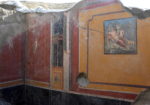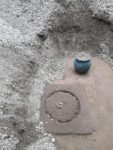 Another high-quality fresco has been discovered in the house where the fresco depicting the myth of Leda and the Swan was discovered last November in Pompeii. This one was found in the atrium and depicts the myth of Narcissus. The vain hunter is depicted staring at his handsome visage reflected in the pool of water beneath him. He is entranced and cannot be budged despite his hunting dog’s tugging desperately at his robe. Behind them is a winged youth, likely a representation of Eros, son and frequent messenger of Aphrodite who in her guise as Nemesis punished the love-rejecting Narcissus by making him falling in love with his own image.
Another high-quality fresco has been discovered in the house where the fresco depicting the myth of Leda and the Swan was discovered last November in Pompeii. This one was found in the atrium and depicts the myth of Narcissus. The vain hunter is depicted staring at his handsome visage reflected in the pool of water beneath him. He is entranced and cannot be budged despite his hunting dog’s tugging desperately at his robe. Behind them is a winged youth, likely a representation of Eros, son and frequent messenger of Aphrodite who in her guise as Nemesis punished the love-rejecting Narcissus by making him falling in love with his own image.
 When Leda was discovered in a bedroom of the villa late last year, archaeologists were concerned that the structure would be endangered by further excavation. The original intent of the dig was consolidation of the excavation fronts along Via Vesuvio in the Regio V neighborhood of the ancient city which has proved an archaeological gold mine beyond even the stratospherically high standards of Pompeii. The slopes of the dig along the 1.8 mile front of Via Vesuvio had put pressure on the already unearthed structures.
When Leda was discovered in a bedroom of the villa late last year, archaeologists were concerned that the structure would be endangered by further excavation. The original intent of the dig was consolidation of the excavation fronts along Via Vesuvio in the Regio V neighborhood of the ancient city which has proved an archaeological gold mine beyond even the stratospherically high standards of Pompeii. The slopes of the dig along the 1.8 mile front of Via Vesuvio had put pressure on the already unearthed structures.
 The exceptional quality and preservation of the frescoes of Leda and Priapus found in the home motivated the team to remodel of the slopes of the excavation fronts and stabilize the ancient structures. They were then able to proceed with the excavation of the villa and the fresco of Leda. On the other side of the bedroom they unearthed floor-to-ceiling frescoes of intense color, deep red and ochre backdrops to elaborate border decorations and the central panel of Narcissus.
The exceptional quality and preservation of the frescoes of Leda and Priapus found in the home motivated the team to remodel of the slopes of the excavation fronts and stabilize the ancient structures. They were then able to proceed with the excavation of the villa and the fresco of Leda. On the other side of the bedroom they unearthed floor-to-ceiling frescoes of intense color, deep red and ochre backdrops to elaborate border decorations and the central panel of Narcissus.
Love and the sweetness of the senses, in all of their varied forms, ooze from the rooms of this elegant dwelling that, even in the entrance hall, welcomed guests with the vigorous and auspicious image of Priapus, which was also documented some months ago and is comparable to the image in the nearby House of the Vettii.
The entire Leda room is characterised by sophisticated Fourth Style decorations, with delicate floral embellishments, interspersed by griffins with cornucopia, winged cupids, still lifes and scenes of combat between animals. The harmony of these exquisite designs even extended to the ceiling, which completely collapsed under the weight of the lapilli, and whose fragments were recovered by restorers and used to reconstruct the story.
Of particular note in the atrium of Narcissus is the still visible trace of the stairs which lead to the upper floor, but above all the rediscovery of a dozen glass containers, eight amphorae and a bronze funnel in the space under the stairs, which was used for storage. A bronze situla (a liquid container) was also found next to the impluvium.
 Pompeii Superintendent Massimo Osanna notes that the decorative motifs appear to be thematically connected so that beauty, sensuality and the pleasures of life would accompany the residents and visitors from room to room. The dramatic height of the first floor walls and the frescoes covering them attest to what a luxurious home this was. The colors are so vibrant that it was likely constructed shortly before Pompeii’s sudden cataclysmic demise.
Pompeii Superintendent Massimo Osanna notes that the decorative motifs appear to be thematically connected so that beauty, sensuality and the pleasures of life would accompany the residents and visitors from room to room. The dramatic height of the first floor walls and the frescoes covering them attest to what a luxurious home this was. The colors are so vibrant that it was likely constructed shortly before Pompeii’s sudden cataclysmic demise.